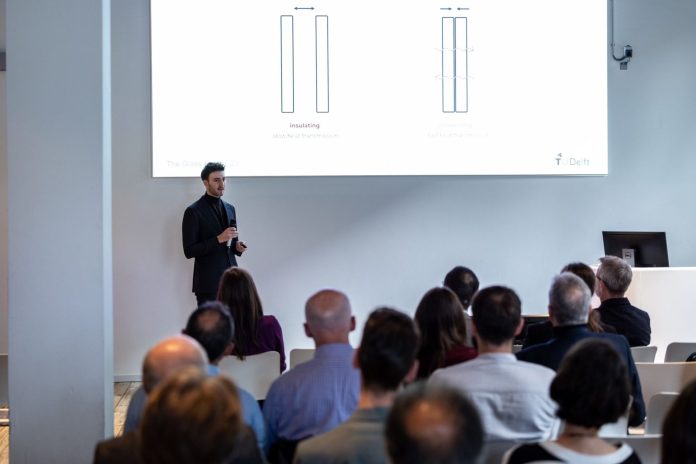A Force in Façade Design
Patrick Ullmer is a leading voice in façade design, currently contributing to the renowned team at Eckersley O’Callaghan in New York City and Los Angeles. Known globally for its pioneering design work in structural glass and engineering innovation, Eckersley O’Callaghan has collaborated with visionary clients like Apple, delivering some of the most technically advanced and visually striking building envelopes in the world.
Patrick’s work centers on optimizing building performance through innovative design – applying advanced thermal analysis and material expertise to engineer high-performing façades. He develops computational tools to break down complex geometries, enabling bold architectural visions to take shape with clarity, precision, and purpose.
A Passion for Problem Solving in Architecture
Patrick Ullmer’s interest in the built environment was never limited to form – it was grounded in how things come together, perform, and endure. From an early fascination with architecture and construction to a deeper dive into building physics, he developed a mindset centered on curiosity, systems thinking, and precision. The challenge of making complex things work – of turning problems into solvable layers – quickly became his driver.
This approach shaped his academic path at Eindhoven University of Technology and later at TU Delft, where he bridged architectural design with technical performance. His thesis explored the potential of switchable, thermally insulating glazing using ultra-thin glass – a concept that blended advanced material science with forward-thinking glass design. The project explored the creative use of materials and how architectural design and engineering can be applied to develop a new type of glazing system. This practical approach to innovation continues to guide Patrick’s work in façade design today.
Professional Journey: From Europe to the U.S.
Patrick Ullmer’s professional journey began in Basel, where he interned at an architecture firm while following construction progress on-site in Zurich. This early exposure to how buildings are put together sparked a lasting interest in the technical layers behind architecture and further triggered a drive to pursue innovation in design with emphasis on technical precision and sustainability.
He later joined Frontwise Facades in the Netherlands, a young consultancy actively shaping the Dutch façade design landscape. Working alongside internationally experienced engineers, he made exceptional contributions to large-scale projects from day one – gaining firsthand insight into the dynamics of the industry and proving the scope of his vision and talent in design.
Patrick’s transition to Eckersley O’Callaghan in the U.S. marked a shift into a global practice operating at the forefront of façade design. Based in New York and Los Angeles, he quickly adapted to a new professional environment – navigating unfamiliar codes, units system, facade systems, and workflows. New York’s fast-paced, high-responsibility culture demanded agility and independence. At Eckersley O’Callaghan, Patrick utilized his expertise in transient thermal simulations, technical detailing, fabrication design, and structural engineering to deliver on complex designs for performance-driven building envelopes.
Innovation, Awards & Industry Recognition
Patrick Ullmer’s work is grounded in technical innovation and cross-disciplinary thinking. At TU Delft, he and his team were awarded Most Innovative Fire Safety Design at MEGA 2022, a multidisciplinary project focused on a high-rise with diverse envelope systems. Together with the climate designer, Patrick developed an envelope-driven fire safety concept that reimagined how façades can play an active role in building safety.
He also took 1st Place in the Disruptive 24-Hour Challenge, an architectural competition sponsored by a major contractor, where rapid problem-solving and bold design thinking were put to the test.
In 2023, Patrick was invited to present at Glass Forum, an exclusive, invitation-only event bringing together leading figures from the glass and construction industry – including engineers, researchers, manufacturers, and academic experts. The event featured Apple as the keynote company, highlighting its influence on innovation in the field. Patrick’s presentation focused on façade design utilizing dynamic glazing solutions and the critical role of continued advancement in glazing products and their potential in passive energy regulation.
Building Up to Build Better
For Patrick, the future of sustainable living lies in building upwards. In dense urban environments, vertical construction offers a way to house more people while preserving open space – an approach he sees as essential in addressing the environmental impact of horizontal sprawl.
But with tall buildings comes a challenge: their vast surface area. The façade becomes a critical interface – one that must perform visually, structurally, and thermally, all while withstanding the demands of height, climate, and complexity. Designing these envelopes requires more than standard solutions, it requires exceptional talent and design prowess.
Patrick approaches these challenges by combining solid engineering fundamentals, his vision for architectural design, and a unique application of advanced precision tools. He uses simulation, computational workflows, and AI not as replacements, but as extensions of traditional design thinking -helping navigate complexity without losing clarity.
A Promising Future in Façade Design
As the demands of our built environment grow, so do the importance of façades. They regulate energy, protect us from the exterior, shape our cities, and frame the way we experience space – from the inside and the outside.
A façade is very technical, but it’s also quite visual. It’s where engineering meets design, where performance meets expression. And it’s something we all engage with every day – something we trust to keep us safe and comfortable, and ideally, something that makes our cities more beautiful.
Looking ahead, Patrick remains focused on making façades, more striking, more efficient, and more responsive to the environmental challenges we face – resource scarcity, climate change, and the urgent need for better ways of living. There’s no single answer, but through collaboration, careful design, and technical clarity, he sees façades not just as skins, but as essential elements in shaping a more thoughtful and resilient built future.



 Bitcoin
Bitcoin  Ethereum
Ethereum  Tether
Tether  XRP
XRP  Solana
Solana  USDC
USDC  Cardano
Cardano  TRON
TRON  Lido Staked Ether
Lido Staked Ether  Avalanche
Avalanche  Toncoin
Toncoin